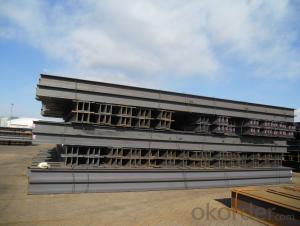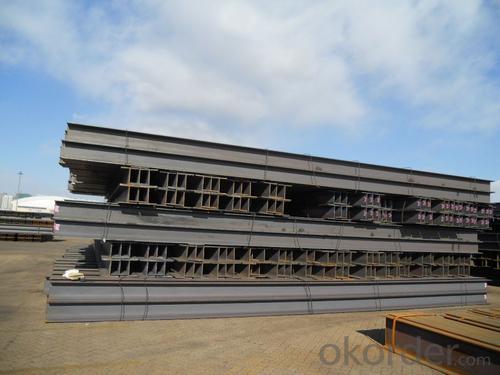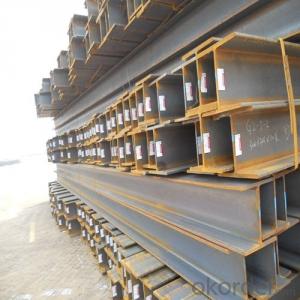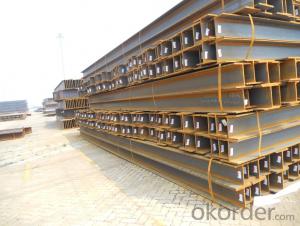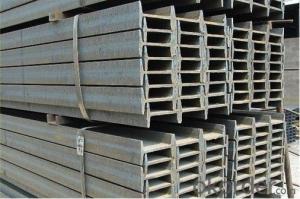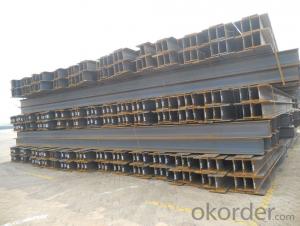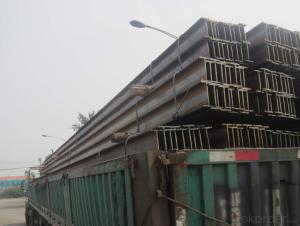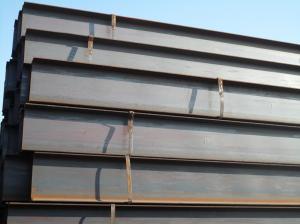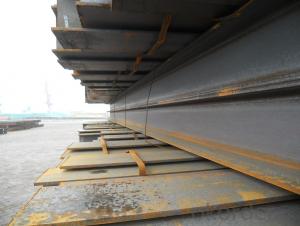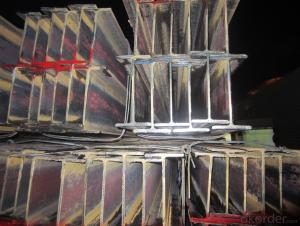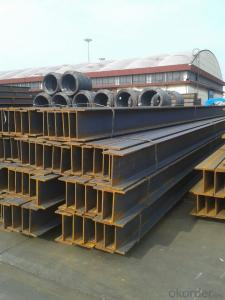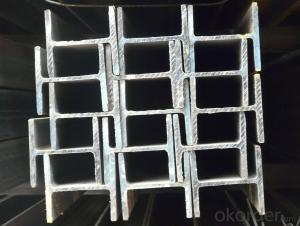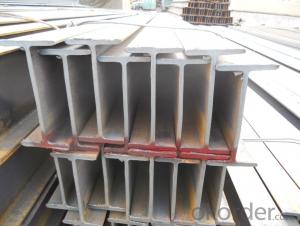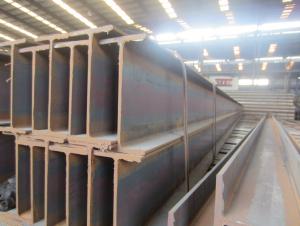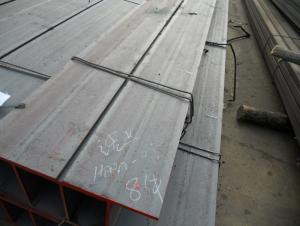High Quality Hot Rolled Jis Standard H Beam
- Loading Port:
- Tianjin
- Payment Terms:
- TT OR LC
- Min Order Qty:
- 25 m.t.
- Supply Capability:
- 1000 m.t./month
OKorder Service Pledge
OKorder Financial Service
You Might Also Like
roduct Description:
Specifications of Hot Rolled Steel H-beam
1. Standard: GB
2. Grade: Q235 or Equivalent
3. Length: 6m,10m, 12m as following table
4. Invoicing on theoretical weight or actual weight as customer request
5.Payment: TT or L/C
6. Sizes:
Category | model (height*width)/ (mm×mm) | Section size/mm | Cross-section area/cm2 | Theoretical Weight/(kg/m) | Moment of inertia/cm4 | radius/cm | Section modulus/cm3 | |||||||
H | B | t1 | t2 | r | Ix | Iy | ix | iy | Wx | Wy | ||||
HW | 100×100 | 100 | 100 | 6 | 8 | 8 | 21.59 | 16.9 | 386 | 134 | 4.23 | 2.49 | 77.1 | 26.7 |
125×125 | 125 | 125 | 6.5 | 9 | 8 | 30.00 | 23.6 | 843 | 293 | 5.30 | 3.13 | 135 | 46.9 | |
150×150 | 150 | 150 | 7 | 10 | 8 | 39.65 | 31.1 | 1620 | 563 | 6.39 | 3.77 | 216 | 75.1 | |
175×175 | 175 | 175 | 7.5 | 11 | 13 | 51.43 | 40.4 | 2918 | 983 | 7.53 | 4.37 | 334 | 112 | |
200×200 | 200 | 200 | 8 | 12 | 13 | 63.53 | 49.9 | 4717 | 1601 | 8.62 | 5.02 | 472 | 160 | |
200 | 204 | 12 | 12 | 13 | 71.53 | 56.2 | 4984 | 1701 | 8.35 | 4.88 | 498 | 167 | ||
250×250 | 244 | 252 | 11 | 11 | 13 | 81.31 | 63.8 | 8573 | 2937 | 10.27 | 6.01 | 703 | 233 | |
250 | 250 | 9 | 14 | 13 | 91.43 | 71.8 | 10689 | 3648 | 10.81 | 6.32 | 855 | 292 | ||
250 | 255 | 14 | 14 | 13 | 103.93 | 81.6 | 11340 | 3875 | 10.45 | 6.11 | 907 | 304 | ||
HM | 150×100 | 148 | 100 | 6 | 9 | 8 | 26.35 | 20.7 | 995.3 | 150.3 | 6.15 | 2.39 | 134.5 | 30.1 |
200×150 | 194 | 150 | 6 | 9 | 8 | 38.11 | 29.9 | 2586 | 506.6 | 8.24 | 3.65 | 266.6 | 67.6 | |
250×175 | 244 | 175 | 7 | 11 | 13 | 55.49 | 43.6 | 5908 | 983.5 | 10.32 | 4.21 | 484.3 | 112.4 | |
HN | 100×50 | 100 | 50 | 5 | 7 | 8 | 11.85 | 9.3 | 191.0 | 14.7 | 4.02 | 1.11 | 38.2 | 5.9 |
125×60 | 125 | 60 | 6 | 8 | 8 | 16.69 | 13.1 | 407.7 | 29.1 | 4.94 | 1.32 | 65.2 | 9.7 | |
150×75 | 150 | 75 | 5 | 7 | 8 | 17.85 | 14.0 | 645.7 | 49.4 | 6.01 | 1.66 | 86.1 | 13.2 | |
175×90 | 175 | 90 | 5 | 8 | 8 | 22.90 | 18.0 | 1174 | 97.4 | 7.16 | 2.06 | 134.2 | 21.6 | |
200×100 | 198 | 99 | 4.5 | 7 | 8 | 22.69 | 17.8 | 1484 | 113.4 | 8.09 | 2.24 | 149.9 | 22.9 | |
200 | 100 | 5.5 | 8 | 8 | 26.67 | 20.9 | 1753 | 133.7 | 8.11 | 2.24 | 175.3 | 26.7 | ||
250×125 | 248 | 124 | 5 | 8 | 8 | 31.99 | 25.1 | 3346 | 254.5 | 10.23 | 2.82 | 269.8 | 41.1 | |
250 | 125 | 6 | 9 | 8 | 36.97 | 29.0 | 3868 | 293.5 | 10.23 | 2.82 | 309.4 | 47.0 | ||
300×150 | 298 | 149 | 5.5 | 8 | 13 | 40.80 | 32.0 | 5911 | 441.7 | 12.04 | 3.29 | 396.7 | 59.3 | |
300 | 150 | 6.5 | 9 | 13 | 46.78 | 36.7 | 6829 | 507.2 | 12.08 | 3.29 | 455.3 | 67.6 | ||
350×175 | 346 | 174 | 6 | 9 | 13 | 52.45 | 41.2 | 10456 | 791.1 | 14.12 | 3.88 | 604.4 | 90.9 | |
350 | 175 | 7 | 11 | 13 | 62.91 | 49.4 | 12980 | 983.8 | 14.36 | 3.95 | 741.7 | 112.4 | ||
400×150 | 400 | 150 | 8 | 13 | 13 | 70.37 | 55.2 | 17906 | 733.2 | 15.95 | 3.23 | 895.3 | 97.8 | |
HT | 100×50 | 95 | 48 | 3.2 | 4.5 | 8 | 7.62 | 6.0 | 109.7 | 8.4 | 3.79 | 1.05 | 23.1 | 3.5 |
97 | 49 | 4 | 5.5 | 8 | 9.38 | 7.4 | 141.8 | 10.9 | 3.89 | 1.08 | 29.2 | 4.4 | ||
100×100 | 96 | 99 | 4.5 | 6 | 8 | 16.21 | 12.7 | 272.7 | 97.1 | 4.10 | 2.45 | 56.8 | 19.6 | |
125×60 | 118 | 58 | 3.2 | 4.5 | 8 | 9.26 | 7.3 | 202.4 | 14.7 | 4.68 | 1.26 | 34.3 | 5.1 | |
120 | 59 | 4 | 5.5 | 8 | 11.40 | 8.9 | 259.7 | 18.9 | 4.77 | 1.29 | 43.3 | 6.4 | ||
125×125 | 119 | 123 | 4.5 | 6 | 8 | 20.12 | 15.8 | 523.6 | 186.2 | 5.10 | 3.04 | 88.0 | 30.3 | |
150×75 | 145 | 73 | 3.2 | 4.5 | 8 | 11.47 | 9.0 | 383.2 | 29.3 | 5.78 | 1.60 | 52.9 | 8.0 | |
147 | 74 | 4 | 5.5 | 8 | 14.13 | 11.1 | 488.0 | 37.3 | 5.88 | 1.62 | 66.4 | 10.1 | ||
150×100 | 139 | 97 | 4.5 | 4.5 | 8 | 13.44 | 10.5 | 447.3 | 68.5 | 5.77 | 2.26 | 64.4 | 14.1 | |
142 | 99 | 4.5 | 6 | 8 | 18.28 | 14.3 | 632.7 | 97.2 | 5.88 | 2.31 | 89.1 | 19.6 | ||
150×150 | 144 | 148 | 5 | 7 | 8 | 27.77 | 21.8 | 1070 | 378.4 | 6.21 | 3.69 | 148.6 | 51.1 | |
147 | 149 | 6 | 8.5 | 8 | 33.68 | 26.4 | 1338 | 468.9 | 6.30 | 3.73 | 182.1 | 62.9 | ||
175×90 | 168 | 88 | 3.2 | 4.5 | 8 | 13.56 | 10.6 | 619.6 | 51.2 | 6.76 | 1.94 | 73.8 | 11.6 | |
171 | 89 | 4 | 6 | 8 | 17.59 | 13.8 | 852.1 | 70.6 | 6.96 | 2.00 | 99.7 | 15.9 | ||
175×175 | 167 | 173 | 5 | 7 | 13 | 33.32 | 26.2 | 1731 | 604.5 | 7.21 | 4.26 | 207.2 | 69.9 | |
172 | 175 | 6.5 | 9.5 | 13 | 44.65 | 35.0 | 2466 | 849.2 | 7.43 | 4.36 | 286.8 | 97.1 | ||
200×100 | 193 | 98 | 3.2 | 4.5 | 8 | 15.26 | 12.0 | 921.0 | 70.7 | 7.77 | 2.15 | 95.4 | 14.4 | |
196 | 99 | 4 | 6 | 8 | 19.79 | 15.5 | 1260 | 97.2 | 7.98 | 2.22 | 128.6 | 19.6 | ||
200×150 | 188 | 149 | 4.5 | 6 | 8 | 26.35 | 20.7 | 1669 | 331.0 | 7.96 | 3.54 | 177.6 | 44.4 | |
Usage & Applications of Hot Rolled Steel H-beam
Commercial building structure ;Pre-engineered buildings; Machinery support structure; Prefabricated structure; Medium scale bridges; Ship-building structure. etc.
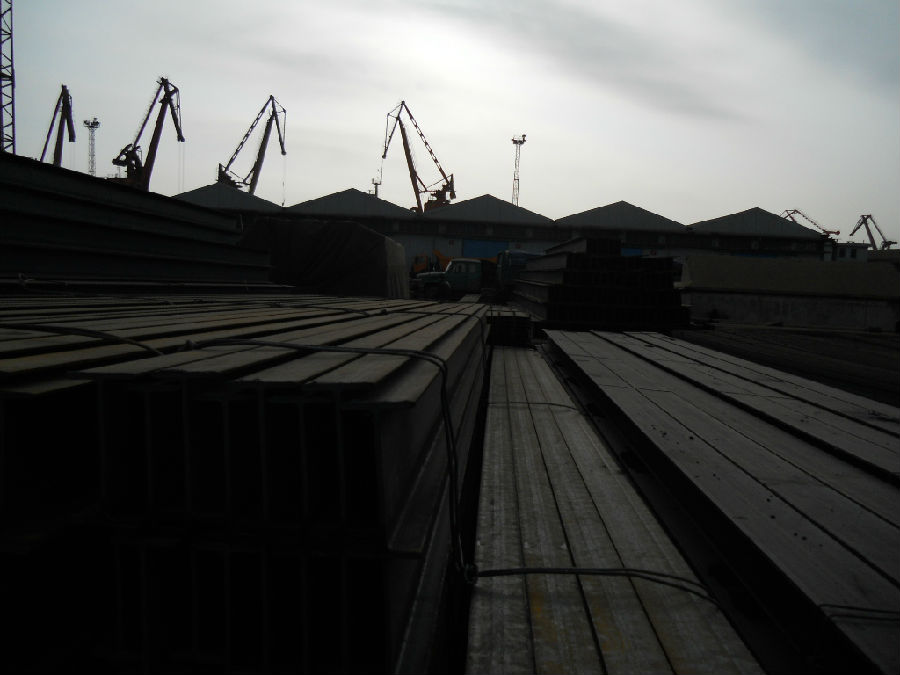

Packaging & Delivery of Hot Rolled Steel H-beam
1. Packing: it is nude packed in bundles by steel wire rod
2. Bundle weight: not more than 3.5MT for bulk vessel; less than 3 MT for container load
3. Marks:
Color marking: There will be color marking on both end of the bundle for the cargo delivered by bulk vessel. That makes it easily to distinguish at the destination port.
Tag mark: there will be tag mark tied up on the bundles. The information usually including supplier logo and name, product name, made in China, shipping marks and other information request by the customer.
If loading by container the marking is not needed, but we will prepare it as customer request.
4. Transportation: the goods are delivered by truck from mill to loading port, the maximum quantity can be loaded is around 40MTs by each truck. If the order quantity cannot reach the full truck loaded, the transportation cost per ton will be little higher than full load.
5. Delivered by container or bulk vessel
Production flow of Hot Rolled Steel H-beam
Material prepare (billet) —heat up—rough rolling—precision rolling—cooling—packing—storage and transportation
- Q: What are the different types of connections for steel H-beams?
- There are several types of connections for steel H-beams, including welded connections, bolted connections, and hybrid connections. Welded connections involve welding the H-beam to other structural members or plates. Bolted connections use bolts and nuts to secure the H-beam to other components. Hybrid connections combine both welding and bolting techniques for added strength and flexibility. The specific type of connection used depends on factors such as the load requirements, structural design, and construction method.
- Q: Are steel H-beams suitable for industrial structures?
- Industrial structures can benefit greatly from the use of steel H-beams. These beams, also known as I-beams or universal beams, are specifically designed to handle heavy loads and provide structural stability. Their unique shape, featuring a wider flange and narrower web, allows for even weight distribution and resistance against bending or twisting forces. Steel H-beams possess several advantages that make them an ideal choice for industrial structures. Firstly, they have a high strength-to-weight ratio, meaning they can support heavy loads while remaining relatively lightweight. This not only makes them cost-effective but also easier to handle during the construction process. Additionally, steel is a durable material that can withstand harsh environmental conditions and resist corrosion, ensuring the longevity and safety of the structure. Another advantage of steel H-beams is their versatility. They can be easily fabricated to different lengths and sizes, providing flexible design options and accommodating various construction requirements. Furthermore, these beams can be joined together either by bolting or welding, allowing for the creation of larger structural components. This makes them suitable for constructing wide-span industrial buildings or supporting heavy machinery and equipment. Moreover, steel H-beams offer excellent structural integrity and stability. Their shape provides resistance against bending and torsion, making them capable of withstanding dynamic loads and seismic forces. This makes them particularly well-suited for industrial structures that are exposed to heavy machinery operations, vibrations, or potential impacts. To summarize, steel H-beams are highly suitable for industrial structures due to their strength, durability, versatility, and stability. They possess efficient load-bearing capabilities, enabling the construction of strong and reliable industrial buildings that can withstand heavy loads and harsh environmental conditions.
- Q: What is the cost of steel H-beams compared to other structural materials?
- When comparing the cost of steel H-beams to other structural materials, it is evident that steel offers a competitive price. The construction industry widely utilizes steel due to its strength, durability, and versatility. While the specific cost may vary depending on factors such as size, grade, and market conditions, steel H-beams generally present a cost-effective solution for structural needs. In contrast to materials like wood or concrete, steel H-beams exhibit superior strength and load-bearing capacity. This quality allows for longer spans and fewer supporting columns, resulting in cost savings in terms of materials, labor, and construction time. Moreover, steel possesses high resistance to environmental factors like moisture, fire, and pests, consequently reducing long-term maintenance costs. Despite the potential fluctuations in steel prices due to market conditions, it remains a favored choice for structural applications due to its availability and competitiveness. When considering the cost of steel H-beams, it is crucial to evaluate other factors such as project requirements, design considerations, and overall budget to determine the most suitable and cost-effective solution.
- Q: What are the factors to consider when selecting steel H-beams for a project?
- When selecting steel H-beams for a project, there are several important factors to consider. 1. Load-bearing capacity: The primary factor to consider is the load-bearing capacity of the H-beam. This includes both the dead load (the weight of the structure itself) and the live load (any additional weight that the structure may support). It is crucial to calculate the expected load and select a beam that can safely support it without deformation or failure. 2. Size and dimensions: The size and dimensions of the H-beam should be chosen based on the specific requirements of the project. The beam's height, width, and thickness will impact its load-carrying capacity and overall stability. It is essential to consult engineering and design guidelines to ensure the appropriate sizing for the project. 3. Material quality: The quality of the steel used in manufacturing the H-beams is crucial for the structural integrity and durability of the project. Factors such as the tensile strength, yield strength, and ductility of the steel should be considered. Higher grades of steel will generally have better strength properties, but they may come at a higher cost. 4. Corrosion resistance: Depending on the project's environmental conditions, it may be necessary to consider the corrosion resistance of the steel H-beams. If the structure will be exposed to moisture, chemicals, or other corrosive elements, selecting a beam with appropriate coatings or using stainless steel may be necessary to prevent deterioration and maintain the structural integrity over time. 5. Fabrication and installation requirements: The ease of fabrication and installation of the H-beams should also be taken into account. Consider factors such as the beam's shape, weight, and connection methods. Some projects may require pre-cut or pre-drilled beams for specific installation requirements, and these factors should be considered during the selection process. 6. Cost: Finally, the cost of the H-beams should be considered while balancing the project's budget with the desired quality and performance. Comparing prices from different suppliers and considering long-term costs, such as maintenance and replacement, can help make an informed decision. Overall, selecting steel H-beams for a project involves careful consideration of load-bearing capacity, size and dimensions, material quality, corrosion resistance, fabrication and installation requirements, and cost. Consulting with structural engineers and adhering to relevant building codes and standards is essential to ensure the safety and success of the project.
- Q: Can steel H-beams be used in the construction of residential complexes or apartments?
- Yes, steel H-beams can be used in the construction of residential complexes or apartments. Steel H-beams are strong and versatile structural components that are commonly used in construction projects. They offer several advantages over other materials such as wood or concrete. Firstly, steel H-beams have a high strength-to-weight ratio, which means they can support heavy loads while being relatively lightweight themselves. This makes them ideal for constructing large or multi-story buildings like residential complexes or apartments. Secondly, steel H-beams provide excellent durability and resistance to various environmental factors such as earthquakes, hurricanes, and termites. They have high tensile strength, which means they can withstand significant forces and deformations without breaking. Moreover, steel H-beams are highly customizable and can be fabricated to meet specific design requirements. They can be easily cut, welded, and bolted together, allowing for flexible construction designs. Additionally, steel is a sustainable and eco-friendly material. It can be recycled indefinitely without losing its inherent properties, making it an environmentally responsible choice for construction projects. In summary, steel H-beams offer numerous advantages that make them suitable for the construction of residential complexes and apartments. Their strength, durability, versatility, and sustainability make them a popular choice among architects and builders in the construction industry.
- Q: How do steel H-beams perform in extreme weather conditions, such as high winds or heavy snow?
- Steel H-beams are known for their superior strength and durability, which make them highly reliable in extreme weather conditions such as high winds or heavy snow. Their unique shape and structural design allow them to effectively resist bending, twisting, and buckling forces, making them ideal for withstanding the challenges posed by severe weather. In high winds, steel H-beams perform exceptionally well due to their high stiffness and resistance to wind loads. The H-shaped cross-section of the beam provides increased stability and prevents it from deflecting or getting damaged even under strong gusts. This characteristic makes H-beams a popular choice in structures located in hurricane-prone areas or regions with frequent high winds. Similarly, steel H-beams are also well-suited to handle heavy snow loads. Their robust construction and high load-bearing capacity make them capable of supporting the weight of accumulated snow without experiencing any significant deformation or failure. This is particularly important in areas where snowstorms are common, as the H-beams ensure the structural integrity of buildings, bridges, or other infrastructures under these extreme conditions. Moreover, steel H-beams are not only resistant to wind and snow loads but also highly durable against corrosion and rust. This is due to the protective coatings and treatments applied to the steel during the manufacturing process. These coatings help prevent the formation of rust and ensure the longevity of the beams, even in harsh weather environments. Overall, steel H-beams have a proven track record of performing exceptionally well in extreme weather conditions like high winds or heavy snow. Their strength, stability, and resistance to both external forces and corrosion make them a reliable choice for various construction projects, providing peace of mind to engineers, architects, and property owners alike.
- Q: What are the different corrosion protection methods for steel H-beams?
- To ensure durability and longevity of steel H-beams, various corrosion protection methods are available. These methods include coating, cathodic protection, VCI, passivation, and maintenance and inspection. Firstly, a common method involves applying a protective coating to the H-beams. This can be achieved through the use of paints, epoxy coatings, or galvanizing. Paints and epoxy coatings act as a barrier, safeguarding the steel from corrosion. Galvanizing, on the other hand, entails coating the steel with zinc, which offers excellent corrosion resistance. Another method, known as cathodic protection, involves utilizing a sacrificial anode made of zinc or aluminum that is electrically connected to the steel H-beams. By doing so, the anode corrodes instead of the steel, providing corrosion protection. This method is particularly advantageous in environments where the steel is exposed to corrosive elements like saltwater. VCI (Volatile Corrosion Inhibitor) is another effective method where volatile corrosion inhibitors are applied to the steel H-beams. These inhibitors release vapors that form a protective layer on the steel's surface, inhibiting corrosion. VCI is particularly beneficial in environments with moisture or high humidity. Passivation is a method that involves treating the steel H-beams with an acid solution to eliminate impurities and contaminants from the surface. This process creates a passive oxide layer on the steel, offering corrosion protection. Passivation is often used alongside other corrosion protection methods to enhance their effectiveness. Regular maintenance and inspection of the steel H-beams are crucial to identify early signs of corrosion. This includes surface cleaning, repairing damaged coatings, and replacing corroded sections if needed. Proper maintenance minimizes the risk of corrosion, ensuring long-term protection. To choose the most appropriate corrosion protection method, it is important to consider the specific environmental conditions and requirements of the steel H-beams. Seeking advice from corrosion protection experts or engineers can assist in determining the most suitable method for a particular application.
- Q: Can steel H-beams be used for gymnasiums?
- Yes, steel H-beams can be used for gymnasiums. Steel H-beams are commonly used in construction due to their high strength and durability. They provide structural support and can withstand heavy loads, making them suitable for gymnasiums that require large open spaces and have high ceilings. Additionally, steel H-beams allow for flexible and customizable designs, making them a popular choice for gymnasium structures.
- Q: Can steel H-beams be used in airport hangar construction?
- Yes, steel H-beams can be used in airport hangar construction. Steel H-beams are commonly used in the construction industry due to their strength, durability, and versatility. They can withstand heavy loads and provide excellent support for large structures like airport hangars. The H shape of these beams allows for increased strength and stability, making them ideal for constructing wide-span buildings such as hangars. Additionally, steel is a preferred material for hangar construction as it is resistant to fire, pests, and rot, ensuring the safety and longevity of the structure. Therefore, steel H-beams are a suitable choice for airport hangar construction.
- Q: How do steel H-beams contribute to the overall sustainability of a construction project?
- Steel H-beams contribute to the overall sustainability of a construction project in several ways. Firstly, steel is one of the most sustainable building materials available. It is 100% recyclable, meaning that at the end of a building's life, the steel beams can be melted down and repurposed for new construction projects. This reduces the demand for raw materials and helps to conserve natural resources. Furthermore, steel H-beams have a long lifespan and require minimal maintenance. They are highly durable and can withstand extreme weather conditions and heavy loads, which reduces the need for frequent repairs and replacements. This longevity translates into reduced waste and lower environmental impact over time. Steel H-beams also offer design flexibility, allowing for efficient use of materials. Due to their high strength-to-weight ratio, they can span longer distances, allowing for greater open spaces in buildings and reducing the need for additional support columns. This not only enhances the aesthetic appeal of the structure but also maximizes the usable space, optimizing the building's energy efficiency and reducing the overall material consumption. Moreover, steel is an energy-efficient material. It can be produced using renewable energy sources, such as wind or solar power, minimizing greenhouse gas emissions during the manufacturing process. Additionally, steel H-beams can be prefabricated off-site, reducing construction time and minimizing on-site energy consumption. Lastly, steel H-beams are highly fire-resistant, which contributes to the overall safety and resilience of a construction project. By withstanding high temperatures, they help to prevent the spread of fire, protecting both the building and its occupants. In summary, steel H-beams contribute to the overall sustainability of a construction project by being recyclable, durable, energy-efficient, and fire-resistant. Their use promotes resource conservation, reduces waste, and enhances the structural integrity and longevity of the building, ultimately minimizing the environmental impact and improving the overall sustainability of the construction project.
Send your message to us
High Quality Hot Rolled Jis Standard H Beam
- Loading Port:
- Tianjin
- Payment Terms:
- TT OR LC
- Min Order Qty:
- 25 m.t.
- Supply Capability:
- 1000 m.t./month
OKorder Service Pledge
OKorder Financial Service
Similar products
Hot products
Hot Searches
Related keywords
